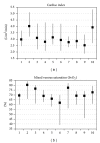Transfusion strategy: impact of haemodynamics and the challenge of haemodilution
- PMID: 25177515
- PMCID: PMC4142166
- DOI: 10.1155/2014/627141
Transfusion strategy: impact of haemodynamics and the challenge of haemodilution
Abstract
Blood transfusion is associated with increased morbidity and mortality and numerous reports have emphasised the need for reduction. Following this there is increased attention to the concept of patient blood management. However, bleeding is relatively common following cardiac surgery and is further enhanced by the continued antiplatelet therapy policy. Another important issue is that cardiopulmonary bypass leads to haemodilution and a potential blood loss. The basic role of blood is oxygen transport to the organs. The determining factors of oxygen delivery are cardiac output, haemoglobin, and saturation. If oxygen delivery/consumption is out of balance, the compensation mechanisms are simple, as a decrease in one factor results in an increase in one or two other factors. Patients with coexisting cardiac diseases may be of particular risk, but studies indicate that patients with coexisting cardiac diseases tolerate moderate anaemia and may even benefit from a restrictive transfusion regimen. Further it has been shown that patients with reduced left ventricular function are able to compensate with increased cardiac output in response to bleeding and haemodilution if normovolaemia is maintained. In conclusion the evidence supports that each institution establishes its own patient blood management strategy to both conserve blood products and maximise outcome.
Figures







References
-
- Hébert PC, Wells G, Blajchman MA, et al. A multicenter, randomized, controlled clinical trial of transfusion requirements in critical care. The New England Journal of Medicine. 1999;340(6):409–417. - PubMed
-
- Horwitz SM, Kelleher K, Thomas Boyce PMT, et al. Anemia and blood transfusion in critically ill patients. Journal of the American Medical Association. 2002;288(12):1499–1507. - PubMed
-
- Rawn JD. Blood transfusion in cardiac surgery: a silent epidemic revisited. Circulation. 2007;116(22):2523–2524. - PubMed
-
- Koch CG, Li L, Duncan AI, et al. Morbidity and mortality risk associated with red blood cell and blood-component transfusion in isolated coronary artery bypass grafting. Critical Care Medicine. 2006;34(6):1608–1616. - PubMed
-
- Andreasen JJ, Dethlefsen C, Modrau IS, et al. Storage time of allogeneic red blood cells is associated with risk of severe postoperative infection after coronary artery bypass grafting. European Journal of Cardio-thoracic Surgery. 2011;39(3):329–334. - PubMed
Publication types
LinkOut - more resources
Full Text Sources
Other Literature Sources

